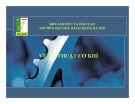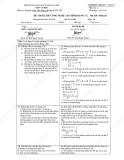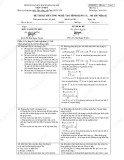
EPJ Nuclear Sci. Technol. 5, 15 (2019)
©B. Hombourger et al. published by EDP Sciences, 2019
https://doi.org/10.1051/epjn/2019026
Nuclear
Sciences
& Technologies
Available online at:
https://www.epj-n.org
REGULAR ARTICLE
Breed-and-burn fuel cycle in molten salt reactors
Boris Hombourger1,2,∗,Jiˇ
ri Kˇ
repel1, and Andreas Pautz1,2
1Paul Scherrer Institut, Nuclear Energy and Safety Division, Laboratory for Scientific Computing and Modelling,
5232 Villigen PSI, Switzerland
2´
Ecole Polytechnique F´
ed´
erale de Lausanne, Laboratory for Reactor Physics and Systems Behavior, 1015 Lausanne,
Switzerland
Received: 1 April 2019 / Received in final form: 1 July 2019 / Accepted: 12 August 2019
Abstract. The operation of a reactor on an open but self-sustainable cycle without actinide separation is
known as breed-and-burn. It has mostly been envisioned for use in solid-fueled fast-spectrum reactors such
as sodium-cooled fast reactors. In this paper the applicability of breed-and-burn to molten salt reactors is
investigated first on a cell level using a modified neutron excess method. Several candidate fuel salts are selected
and their performance in a conceptual three-dimensional reactor is investigated. Chloride-fueled single-fluid
breed-and-burn molten salt reactors using enriched chlorine are shown to be feasible from a neutronics and
fuel cycle point of view at the cost of large fuel inventories.
1 Introduction
Currently, the vast majority of existing reactors is com-
posed of reactors operating on an open uranium fuel cycle
that, on the one hand, cannot achieve net breeding of
fissile material, and on the other hand have limited dis-
charge burn-ups (up to approximately 5% fissions per
initial metal atom (FIMA)). These reactors therefore
need a fissile fuel make-up using some degree of ura-
nium enrichment, as well as release important amounts
of unfissioned actinides to the waste stream, resulting in
their arguably poor fuel efficiency (approximately 0.05%
of mined natural uranium).
Conventional breeder reactors alleviate this problem
by converting more of their fertile feed into fissile mate-
rial (positive breeding gain) and adopting fuel recycling
to recover fissile material and remove fission product
(FPs) from the nuclear fuel, thereby substantially increas-
ing their fuel efficiency. However, reprocessing comes
at an increased fuel cycle cost as well as an increased
proliferation risk if fissile material is separated during
processing.
Instead, the idea of instead operating breeder reactors
on an open cycle without actinide separation and discharg-
ing the fuel at a sufficiently high burn-up for the reactor
to remain self-sustainable, termed breed-and-burn (BNB),
has been considered. While it represents an interesting
compromise between both previous cases, the techno-
logical challenge of reaching high burn-ups has proved
∗e-mail: boris.hombourger@protonmail.com
problematic due to maximum cladding fluence limita-
tions. The stringent requirements on the neutron economy
needed for breeding implies it has mainly been considered
for implementation in sodium-cooled fast reactor (SFRs)
but also in other fast reactors.
However, implementing some form of BNB cycle in
Molten salt-fueled reactors1(MSRs) could provide an
alternative answer to the challenges encountered in solid-
fuel fast reactors. Indeed, externally-cooled MSRs use
their molten salt fuel as coolant and therefore have no
cladding material in the core. Additionally, liquid fuels
are not embrittled by radiation and can thus theoretically
remain in core indefinitely.
In this work, the feasibility of implementing a BNB
cycle in MSRs is investigated from a neutronics and fuel
cycle point of view. First, the concept of BNB is discussed
in more details in Section 2. Mathematical models used
to investigate performance of various potential fuels are
explained in Section 3. The performance of several can-
didate salts is evaluated for BNB on a zero-dimensional
level in Section 4. Finally, potential reactor charateristics
of three-dimensional, finite core designs are computed and
compared in Section 5.
2 Breed-and-burn fuel cycle
BNB reactors are an old idea dating back to a least
the time of the Second International Conferences on the
1In this paper, the acronym molten salt reactor (MSR) only refers
to molten salt-fueled reactors and not molten salt-cooled reactors which
are normally included under the MSR umbrella.
This is an Open Access article distributed under the terms of the Creative Commons Attribution License (http://creativecommons.org/licenses/by/4.0),
which permits unrestricted use, distribution, and reproduction in any medium, provided the original work is properly cited.

2 B. Hombourger et al.: EPJ Nuclear Sci. Technol. 5, 15 (2019)
Peaceful Uses of Atomic Energy [1] during which Feinberg
highlighted the practicality of not having to reprocess
the fuel of a fast reactor during the cycle. It has been
investigated by researchers such as Klaus Fuchs [2], which
investigated the possibility of an homogeneous BNB reac-
tor and Edward Teller [3] which brought the idea of
a gas-cooled and thorium-fueled BNB reactor. Japanese
researchers [4] have brought the idea of a fission wave
propagating uniaxially to avoid the radial redistribution
of heat sources in the core which complicates core design.
Most recently the company TerraPower has been develop-
ing a sodium-cooled BNB reactor since 2006 [5]. Interested
readers are referred to a recent article [6] which reviews
the concept in many more details.
Fundamentally, a BNB reactor is a reactor capable of
operating on a fertile-only feed in an open cycle without
actinide separation from its discharged fuel, by opposition
to a classical breeder reactor, sometimes called seed-and-
blanket, in which the fissile elements are mostly bred
in a dedicated part of the reactor (blanket) which is
reprocessed and its actinides separated at relatively low
discharge burn-up to produce new fuel with a higher con-
centration of fissile elements. It must be mentioned that
there are two main types of BNB reactors:
– traveling wave reactor (TWRs), in which a fission
wave propagates in a static fuel, and
– standing wave reactor (SWRs), in which the fuel is
moved and the flux does not propagate.
While TWRs are simpler because it is not be necessary to
shuffle fuel in the core, the technological challenges posed
by the fluences necessary to achieve BNB are substantial.
In SWRs, the fuel can be moved to regions where it is
the most effective depending on its burn-up: for example,
highly burnt fuel need not be in a high flux region as it will
be a net neutron absorber. Therefore, cladding fluence can
be decreased compared to the TWR. Moreover, in the case
of strictly static fuel, inhomogeneity of the neutron flux
due to the finite size of the core leads of a loss of efficiency
in the fuel because of lower burn-up at the extremities of
fuel assemblies. It has been proposed to make the fuel
move radially as well as axially (3D shuffling) to alleviate
this limitation [7].
The necessity of conserving a positive breeding gain
without actinide separation applies stringent requirements
on the neutron economy of the reactor. Therefore, the
design space is generally limited to reactors possessing:
– a hard neutron spectrum to limit parasitic neutron
captures on structural materials and FPs,
– a large core to lower neutron leakage, usually coming
at the cost of worsened safety parameters (such as
void reactivity worth) in liquid metal fast reactors,
– an actinide-dense fuel form to further improve both
previous factors.
Technologically, one of the most limiting factors is the
maximum allowable fluence on the cladding because its
integrity must be guaranteed with sufficient safety mar-
gins. Some concepts lead to displacement per atom (dpa)
values in the cladding tubes of up to 1200 dpa, while vari-
ous optimization measures can be taken to bring this value
down to at least 350 dpa, which is still higher than the
200 dpa reference cladding materials such as HT9 have
been tested up to [7]. For example, fuel re-cladding can
be considered, with some associated cost and technical
complications.
However, a third type of BNB can be conceived when
implemented in an externally-cooled MSR in which the
primary coolant is the fuel salt, which would bring an
alternative. It has the advantages that:
– the fuel being homogeneously mixed, there is no loss
of fuel efficiency due to flux inhomogeneities,
– the absence of cladding tubes implies that fuel
residence time would not be limited by fluence
considerations (while remaining a limiting factor
for the vessel lifetime, however without substantial
differences compared to other fast-spectrum MSR
concepts),
– the void reactivity will remain negative in the case
of a fast-spectrum system as long as provisions are
made for the salt to be able to expand freely upon
heating up,
– the properties of molten salts should allow higher
outlet temperatures than are possible in a liquid
metal-cooled reactor,
– insoluble and volatile FPs will naturally be removed
from a molten salt mixture, which can be enhanced
by He bubbling, as is foreseen in many MSR designs.
This work builds on preliminary findings on the fea-
sibility of BNB in MSRs [8–10]. Additionally, [11] inves-
tigated the feasibility of implementing a BNB cycle in
an internally-cooled MSR in which the fuel is contained
in separate tubes and cooled by another salt, based on
Moltex energy’s stable salt reactor concept [12]. This
different implementation was not explicitely considered
in the present work, however, as it is closer to the
implementation of BNB in a solid-fuel reactor.
3 Model of a breed-and-burn molten salt
reactor
Quantities of interest in the evaluation of the performance
of candidate fuels or geometries for use in BNB reactors
include the minimum and maximum burn-ups achievable,
as well as the resulting multiplication factors.
The neutron excess method [13,14] uses a simple neu-
tron balance for a unit element of fuel to compute the
net number of neutrons produced as function of time or
burn-up, based on the net number of neutrons produced
after a given time in flux, which in the zero-dimensional
case is given by:
P(t) = Zt
0
νF (θ)−A(θ) dθ=Zt
0
[νΣf(θ)−Σa(θ)] φ(θ) dθ
(1)
in which Pis the net number of neutrons produced, ν
the average number of neutrons per fission, Fand Athe

B. Hombourger et al.: EPJ Nuclear Sci. Technol. 5, 15 (2019) 3
fission and absorption rates, and Σfand Σathe fission and
absorption macroscopic cross-sections, and φthe neutron
flux. The evolution of rates and cross-sections as function
of time can be obtained by depleting a unit cell of the
configuration of interest.
While this description is adequate to model a fuel
element of a static-fuel reactor, in an externally-cooled
(circulating fuel) MSR the fuel is constantly mixed. At
discharge, the fuel will be a mixture of volumes that have
spent different amounts of time in the core and therefore
have been exposed to different fluences, unlike the fuel of
a solid-fuel reactor which will have spent exactly the same
amount of time in the core.
This difference can be modeled using the concept of
residence time distribution (RTDs) of ideal reactors [15].
One can define an exit age distribution E(t)describing
the age (time spent in the reactor) of fuel taken from it
and an internal age distribution I(t)describing the age of
the contents of the reactor. In the case of a so-called Plug
Flow Reactor in which the contents do not mix and spend
the same amount of time in the reactor, these are:
ESF(t) = δ(t−τdis)ISF(t) = 1
τdis
[1 −H(t−τdis)] (2)
in which δis the Dirac delta function and Hthe Heaviside
step function. This RTD models that of a single-batch
static-fuel (SF) reactor whose fuel is entirely discharged
at a time τdis.
In the case of a MSR whose fuel is constantly discharged
and replenished, the distribution is that of a so-called
continuously-stirred tank reactor (CSTR) in which the
mixed fuel (MF) is continuously mixed and discharged at
a rate ˙vfrom a total fuel volume V:
EMF(t) = ˙v
Vexp −˙v
Vt=1
τexp −1
τt
IMF(t) = EMF(t)(3)
in which the discharge cycle time τ=V
˙vwas defined,
which is the time needed to discharge the whole fuel vol-
ume, and also the average residence time of a fuel element
in the core, as will be shown later. It must be noted
that the exit and internal distributions are equal since
the contents of the reactor are supposed to be instantly
and continuously mixed, therefore they have the same dis-
tribution. For comparison, the distributions are illustrated
in Figure 1.
The RTDs can be used to derive average values pertain-
ing to the reactor. For example, the average age of fuel at
discharge Tdis and in the reactor Tin is given by:
Tdis =Z∞
0
t E(t) dtTin =Z∞
0
t I(t) dt. (4)
Using equation (2) into (4) yields, for a static-fueled
reactor:
Tdis,SF =Z∞
0
t δ(t−τdis) dt=τdis
Tin,SF =Z∞
0
t1−H(t−τdis)
τdis
dt=τdis
2.
Fig. 1. Exit (top) and internal (bottom) residence time distri-
butions for static- and mixed-fuel reactors of equal discharge and
cycle times τdis =τcycle as function of time.
While using (3) in (4) for a mixed-fuel reactor, one gets:
Tdis,LF =Z∞
0
t1
τexp −1
τtdt=τTin,LF =Tdis,LF =τ.
In both cases the results are quite trivial: in a static-fuel
reactor the average age at discharge is the discharge time
and the average age of fuel in the core is half of that, while
in the case of mixed fuel the average ages are equal to the
average residence time.
Nevertheless RTDs can be used to obtain the net neu-
tron excess at discharge of the fuel as function of the
discharge time τ:
P(τ) = Z∞
0
dt E(t, τ )Zt
0
dθ P (θ).(5)

4 B. Hombourger et al.: EPJ Nuclear Sci. Technol. 5, 15 (2019)
Fig. 2. Comparison of the neutron excess and equilibrium k∞
using static-fuel and mixed-fuel distributions.
Computing (5) using (1) and (2) yield a trivial result:
PSF(τ)= Z∞
0
dt δ(t−τ)Zt
0
dθ P (θ)= Zτ
0
dθ P (θ) = P(τ).
(6)
Equation (6) yields the trivial result that for a static-fuel
reactor the net number of neutrons produced at discharge
of the fuel is given by P(τ). However, in the case of a
mixed-fueled reactor, one gets:
PMF(τ) = Z∞
0
dt1
τexp −1
τtZt
0
dθ P (θ).
The same process can be repeated for the number of
neutrons absorbed A:
A(τ) = Z∞
0
dt E(t)Zt
0
dθ A(θ).
The equilibrium k∞can then be approximated by the
ratio of neutrons produced to the neutrons absorbed:
keq
∞(τ) = P(τ) + A(τ)
A(τ)= 1 + P(τ)
A(τ).(7)
The differences between static and mixed-fuel distribu-
tions can be further illustrated by comparing their neutron
excess and k∞distributions, as is done in Figure 2 using a
NaCl UCl3salt. The minimum and maximum burn-ups
are given by
P(BUmin) = P(BUmax) = 0
and are also visibly those point at which
k∞(BUmin) = k∞(BUmax) = 1.
It can be noticed that in the case of the mixed-fuel dis-
tribution, the minimum discharge burn-up is higher than
that of the static-fuel one, due to the fact that in a mixed-
fuel core the youngest fuel (containing fissile isotopes) is
Fig. 3. Evolution of the neutron production (νΣf) and absorp-
tion macroscopic cross-sections as well as cell k∞as function of
the total fluence for the NaCl UCl3(68–32 mol%) case.
already partially discharged due to mixing. On the other
hand the maximum burn-up achieved in the static-fuel
case is slightly lower due to the fact that in a mixed-fuel
core the oldest fuel is also partially removed and replaced
by fertile isotopes.
To test the method, several test salts whose charac-
teristics are detailed in Section 4 were computed using
this model and the EQL0D procedure for the cell calcu-
lations and discrete equilibrium points at fixed discharge
rates (and thus burn-ups) were calculated using EQL0D
as well.
The EQL0D procedure is a MATLAB®- and Serpent-
based burn-up calculation tool with specific features for
the simulation of MSR fuel cycles [16]. It uses the Serpent
Monte-Carlo code [17] to obtain and update neutron reac-
tion rates then used by the MATLAB®script to compute
fuel evolution using the Chebyshev Rational Approxi-
mation Method (CRAM, [18]) and criticality. EQL0D
can perform the necessary changes to fuel composition
(removal of FPs, refueling, criticality control by compo-
sition adjustments, etc.) in a batch-wise or continuous
(on-line) manner to simulate various fuel cycles. Finally,
it possesses both standard finite-step burn-up and equi-
librium search modes. In the calculations shown in this
paper, insoluble and volatile FPs are removed with a 30 s
removal time.
First, the evolution of unit cells containing the evalu-
ated salts is computed using the EQL0D by burning them
from 0% FIMA to approximately 100% FIMA at constant
flux in sufficiently fine time-steps to obtain a good approx-
imation of continuous data. The reaction rates as function
of fluence are then used in conjunction with the model of
(7) to obtain a prediction of the equilibrium k∞values as
function of discharge rate (and thus, burn-up). An exam-
ple of the evolution of the neutron production (νΣf) and
absorption macroscopic cross-sections as well as the cell
k∞are given in Figure 3.

B. Hombourger et al.: EPJ Nuclear Sci. Technol. 5, 15 (2019) 5
Fig. 4. Evaluation of the k∞at equilibrium using direct
calculation (crosses) and the neutron excess method (lines).
For comparison purposes, individual equilibrium calcu-
lations using EQL0D are then carried out by selecting
several arbitrary discharge rates, and the same unit cells
are then iteratively burned and refueled until equilibrium
is reached and both the fuel composition and cell k∞value
do not vary any more. These point values obtained by
direct calculation can then be compared to the continu-
ous values predicted by the model. The comparison of the
results obtained by these two methods can be made using
Figure 4.
The agreement is arguably satisfactory for scoping
studies, although it should be noticed that the method
seems to slightly underestimate the k∞at equilibrium for
Th-containing salts.
4 Fuel salt mixture selection
In this section, several candidate salts and configurations
were evaluated for BNB. First, the candidate salts and
their properties such as melting point and density are
introduced and the way they were derived is explained.
Afterwards, results pertaining to fluoride salts, in a
moderated and non-moderated configuration, are pre-
sented. Finally, the results pertaining to chloride salts are
presented, with a focus on the enrichment level of the
chlorine isotopes.
4.1 Candidate salts and properties
Selection of a fuel salt mixture in MSRs is constrained by
several requirements, including:
– low melting point: melting temperatures below
500 ◦C are usually favored, while melting temper-
atures below 550 ◦C are often considered acceptable,
– low capture cross-section for salts intended for
thermal-spectrum MSRs,
– low scattering for salts intended for fast-spectrum
MSRs,
– high solubility of actinides.
The last requirement is particularly relevant to BNB
MSRs due to the necessity to minimize the total actinide
inventory by decreasing the critical volume of salt.
The candidate salt mixtures were selected and their
melting point deduced from phase diagrams in the liter-
ature. Their densities were computed using the additive
molar volumes approximation [19], which gives for the
density of a mixture ρmix:
ρmix(T)≈PixiMi
PixiVi(T)(8)
in which xiis the molar fraction of component i,Mi
is its molar mass, and Vi(T)is its molar volume at the
reference temperature. Linear interpolation can yield den-
sity approximations between two reference temperatures.
Densities were computed using equation (8) and single-
compound density data from [19] for fluoride salts and
data from [20] for chloride salts. Since no data concerning
Pu trifluoride and trichloride could be found, the density
of the base salt was assumed. The melting points were
approximated using phase diagrams from [21].
Table 1 provides a summary of pure compounds and
potential fuel salts for a BNB MSR and their densities at
900 K. While chloride salt mixtures are obvious candidates
due to their hard spectrum, simple fluoride salt mixtures
were nonetheless investigated despite their relatively soft
neutron spectrum.
A higher density of actinides improves a fuel salt’s
performance, such as the critical core size, by:
– decreasing the amount of captures on salt nuclides,
– decreasing the neutron leakage, and
– hardening the neutron spectrum.
The mixtures were therefore selected so as to maximize
the actinide content with a maximum melting point of
500 ◦C if at all possible. Salt mixtures containing UCl4
and ThCl4have noticeably lower melting points. How-
ever, it is expected that UCl4is unstable and corrosive at
higher temperatures. Due to the large number of neutrons
per fission of Pu isotopes, U-containing salts perform bet-
ter than Th-containing ones. A compromise can thus be
reached by mixing both fertile materials to optimize the
melting point of the mixture. For this purpose the mixture
NaCl ThCl4UCl4(50–25–25 mol%) was investigated as
well.
4.2 Fluoride salts
Fluoride salts have the advantage of having been much
more investigated for use as fuel salts than chloride salts,
as well as containing more actinides per unit volume than
many chloride salts. Moreover, the softer neutron spec-
trum decreases leakage compared to the case of chloride
salts. Additionally, they can be used in a thermal spec-
trum. In this section, they were evaluated for use in a










![Đề thi Công nghệ tạo hình dụng cụ năm 2020-2021 - Đại học Bách Khoa Hà Nội (Đề 4) [Kèm đáp án]](https://cdn.tailieu.vn/images/document/thumbnail/2023/20230130/phuong62310/135x160/3451675040869.jpg)







![Ngân hàng trắc nghiệm Kỹ thuật lạnh ứng dụng: Đề cương [chuẩn nhất]](https://cdn.tailieu.vn/images/document/thumbnail/2025/20251007/kimphuong1001/135x160/25391759827353.jpg)







